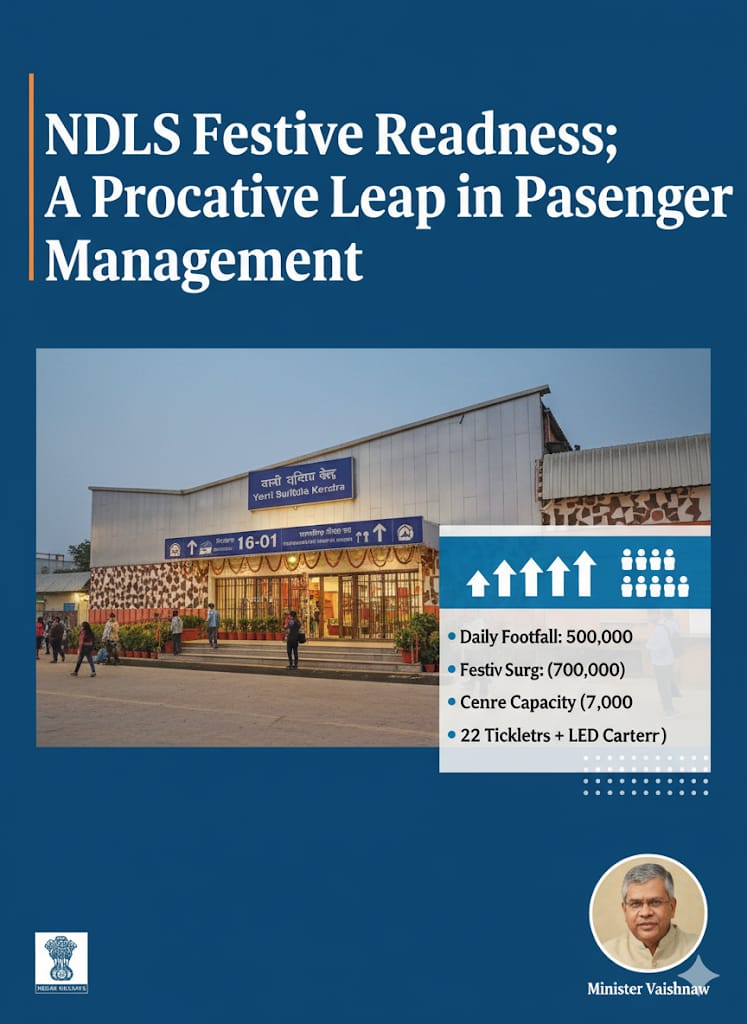
The inauguration of the new Yatri Suvidha Kendra (Passenger Facilitation Center) at the New Delhi Railway Station (NDLS), as announced by the Union Railways Minister, marks a significant, data-driven leap in passenger management and infrastructural readiness, particularly ahead of the annual festive season surge. This state-of-the-art facility is not merely a waiting hall; it represents a strategic intervention designed to mitigate the chronic overcrowding that characterizes Indian Railways during major festivals like Diwali and Chhath.
The Data Behind the Demand
To truly appreciate the necessity of this new facility, one must first consider the sheer scale of passenger movement during the festive period. New Delhi Railway Station, classified as an NSG-1 station, is one of the nation's busiest hubs. Its daily footfall of approximately 500,000 passengers typically surges by 40% to nearly 700,000 passengers a day during the peak festive rush. This exponential increase puts immense pressure on existing infrastructure, often leading to bottlenecks, safety concerns, and a poor passenger experience.
The railway network as a whole witnesses an unprecedented travel migration. Official data from the Ministry of Railways reveals that during a recent festive season (October to November), Indian Railways facilitated over 12,000 special train services, a testament to the colossal demand. On a single peak day, the network has even transported over 3 crore passengers. The Northern Railway zone, which NDLS falls under, is consistently among the highest in running special trains, underscoring its pivotal role as a departure point for travellers heading to states like Uttar Pradesh and Bihar.
Logic of the New Infrastructur
The Yatri Suvidha Kendra, built at the NDLS main entry, directly addresses the core logistical challenge: crowd control and flow management. The 5,100 square meter facility is engineered to accommodate up to 7,000 passengers at any given time, effectively creating a massive, dedicated holding area that prevents station circulation spaces and platforms from becoming dangerously congested.
The design is fundamentally logical, dividing the centre into three distinct functional zones:
- Pre-Ticketing Zone (1,218 sq. m): This space manages passengers before they enter the main ticketing area.
- Ticketing Zone (2,860 sq. m): Housing 22 ticketing counters and 25 Automatic Ticket Vending Machines (ATVMs), this zone streamlines the purchase process. The sheer number of counters aims to drastically cut down waiting times, a major point of friction.
- Post-Ticketing Zone (1,150 sq. m): This area acts as a comfortable waiting space for passengers who have secured their tickets, featuring seating for 200 passengers and cooling via High Volume Low Speed (HVLS) fans.
This segmentation ensures unidirectional passenger flow, preventing the mixing of incoming, ticketing, and waiting crowds. By localising a significant portion of the waiting population in a dedicated, amenity-rich environment, the centre frees up crucial platform space, allowing for more efficient train operations and safer boarding.
Enhancing Passenger Comfort and Security
The investment goes beyond mere logistics, elevating the overall passenger experience. The provision of amenities such as a dedicated toilet block (652 sq. m) and a robust RO-based drinking water system acknowledges the need for basic comfort during long waits. For the modern traveller, the centre is equipped with multiple device charging points, further integrating utility with convenience.
Crucially, the facility is a security enhancement tool. Equipped with CCTV cameras and advanced luggage scanning equipment, it centralises surveillance and screening. The dedicated entry-exit points, guided by tactile tiles for differently-abled passengers, ensure an inclusive and secure environment. The deployment of 24 passenger announcement systems and LED electronic information displays also means timely and accurate travel information, a critical factor in managing passenger anxiety and movement during delays or platform changes.
A Blueprint for Nationwide Modernisation
The success of this pilot project at NDLS is clearly intended to serve as a blueprint for railway station modernisation across the country. As Minister Vaishnaw noted, similar Yatri Suvidha Kendras will be developed at other stations nationwide. This strategic approach, informed by the quantifiable increase in festive travel demand, positions Indian Railways to move from a reactive, crisis-management approach to a proactive, capacity-building strategy.
The new Kendra is an excellent example of using architectural design and modern amenities to meet a massive logistical challenge. By systematically addressing high-volume bottlenecks and prioritising passenger comfort, the NDLS project is set to provide a template for ensuring that the convenience of rail travel is maintained even during the busiest periods of India's annual migration.





















